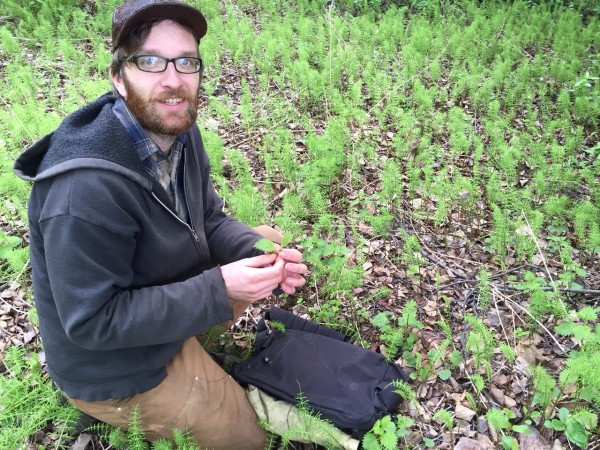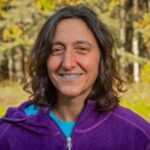
Looking for salad ingredients? Want a new type of tea? No need to head to the store, just look outside your door–even if you live in the middle of the city. Some Anchorage residents are urban gatherers.
Matthew Lohr rides his bike up the Chester Creek Trail in midtown Anchorage and pulls off to the side, not far from a busy road.
“So this is a spot I go to in the spring a lot,” he says, pointing to a shady field of horsetails and nettles. “And it’s kind of fun ’cause when you’re standing on the trail, you really don’t notice there’s a lot of nettles here. But once you start walking in it, all underneath here, this is all nettles.”
He bends down and starts plucking off the top two tender leaves with his bare hands, despite the fact that stinging nettles, well, sting.
“I kind of relish the sting because it’s a reminder that spring is here,” he quips.
The fuzzy, jagged-edged leaves fill his bag. Lohr’s getting enough for the evening’s stir-fry and some extras to dry for the upcoming winter. He says gathering is a fun way to stay engaged with the environment and provide friends with healthy, local foods.
Lohr is an urban gatherer,one of the people you see on the side of the trail with grocery sacks filled with dandelion greens, fiddlehead ferns, fireweed shoots, and even devil’s club. Michelle Wilbur is another.

“Everybody knows Devil’s Club, right? You’re not going to mistake Devil’s Club,” says Michelle Wilbur, who leads wild edibles walks for Alaska Community Action on Toxics and gathers for her family. “In the early spring you go out and see these big spiky stalks coming up and you think, ‘There’s nothing I would want to eat about that.’ And the name makes you think they would be ultimately poisonous.”
Wilbur leads wild edible walks for Alaska Community Action on Toxics and gathers for her own family.
She fingers a tiny, pale green shoot. “But the new little shoots, when they first come out, the spines are furry instead of spiney in the very beginning. So you need to get them really early. It’s way too late right to pick devil’s club.”
She hands me a tiny shoot, one of the last of the season, and describes it like a hoppy IPA.
“It reminds me of really bitter carrots,” I reply.
On the grass, Wilbur displays a wild-harvested salad bar. The greens are lemony and sharp or bitter or nutty. Wilbur says they’re loaded with nutrients and grow everywhere, you just need a knowledgeable friend or a guidebook to make sure you gather the right ones.
“Every year when I’m putting in these annual gardens, and I’m going out and harvesting all these nettles that nobody’s tending, and there’s huge plots of them I think ‘Why? Why don’t I just harvest nettles instead of babying these little broccoli starts along?’ But they’re both good,” she laughs.
Wilbur emphasizes you need to be aware of your surroundings when you harvest. Don’t clear out an area — just pick a few so the plants can grow back.
And make sure the plants you’re picking haven’t been sprayed with herbicides or pesticides.
Tim Stallard, the invasive plant program coordinator with the Anchorage Parks Foundation, says herbicides are used sparingly in the city’s parks to kill things like the invasive flowery, sweet-smelling Bird Cherry.
“The Bird Cherry is like the Medusa where if you cut off its head, it grows ten more. If you just cut it down then the stump will sprout and the roots themselves can sprout up to 30 feet away.”
So they apply herbicides directly to the stumps They also do limited spraying for Canada Thistle when necessary. For larger projects they get approval from community councils first and always post signs to let people know about the chemicals. But Stallard says people gathering food need to use common sense.
“If you go into an area and see dead plants or damaged plants, you know obviously, something’s not right. And that something’s not right should trigger in their mind, and you wouldn’t want to gather plants in that area.”
Back on the Chester Creek Trail, Lohr digs his fingers into the soil to harvest a dandelion root.
“So this isn’t that big. If it’s looser soil, I’ve found that you’ll get bigger roots,” he says, holding up a scraggly piece.
When he gathers enough, he’ll dry them, grind them, and make a hot tea-like beverage. But for now, he tears off a leaf and starts eating.
Anne Hillman is the healthy communities editor at Alaska Public Media and a host of Hometown, Alaska. Reach her atahillman@alaskapublic.org. Read more about Annehere.





